
Character AI Plus - Your Gateway To Increased Productivity
Nova Hawthrone
November 26, 2025
OpenAI revolutionized the artificial intelligence industry with the launch of ChatGPT in 2022 for public interaction. This AI Chat assistant enables users to search, automate, and optimize their daily tasks with precision and perfection. The OpenAI company continuously increases ChatGPT's effectiveness, ensuring remarkable functionality and user experience.
The level of its effectiveness can be estimated from the fact that other giant companies, such as Microsoft, Google, and others, have also launched their generative AI tools for users to capture the ChatGPT market.
For those looking for a comprehensive guide on how to use ChatGPT but don’t know where to start, this discussion is a piece of mastering this need. In this article, we will learn the following topics:
So, let's explore every bit of ChatGPT and learn it properly.
Artificial intelligence has mastered everything and is revolutionizing every sector of our lives. From customer satisfaction to analyzing large amounts of data, automation to image generation, AI has spanned everything.
In the following section, you will learn about the core of ChatGPT and how it works seamlessly. So, let's have a look at them!
ChatGPT is an AI-powered platform developed by OpenAI that consists of large language models with a Generative Pre-Trained Transformers architecture. This AI chat assistant allows you to interact in the most human-centric manner and generate various forms of content depending on your text prompts.
Whether you need to generate articles, want to analyze a large set of data, or need to write functional code, ChatGPT has got you covered. Overall, ChatGPT's natural language processing ability enables it to automate your text-related tasks efficiently and perfectly.
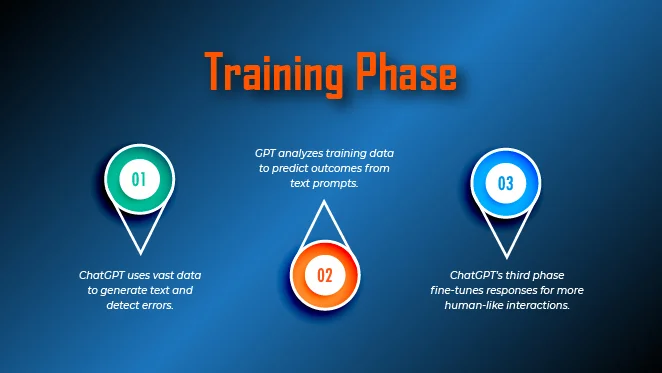
ChatGPT is one of the most advanced AI chat assistants that enables you to generate text-based responses against your prompts. The ChatGPT platform works seamlessly using advanced neural network architecture that enables it to generate high-quality content in seconds.
We have broken down ChatGPT's working model in the following section. Let's have a look at it:
Once the ChatGPT AI model trained on database and fine-tuned, the very next phase of its working is generating text.
It continues this process iteratively until it reaches a predefined length or a designated stopping point. In addition, ChatGPT needs to understand the text the same way humans do truly; instead, it finds the statistical relationship in the data it is trained on. This is why the more data you provide, the more targeted results it provides.
That is how ChatGPT works, incorporating various factors and providing you with concise and targeted results against your text prompts. Now, let's learn how you can get started with ChatGPT to generate text-based responses.
The use of ChatGPT is straightforward! There are no complex steps you have to follow. We have mentioned every step of using ChatGPT simply. Let's learn how to get started with ChatGPT:
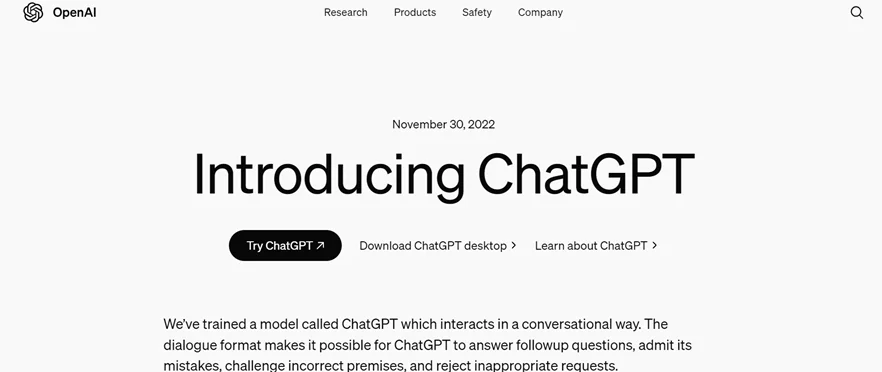
The first step to start engaging with ChatGPT is to create an account. To do so, you need to go to the official website of ChatGPT by OpenAI by clicking here
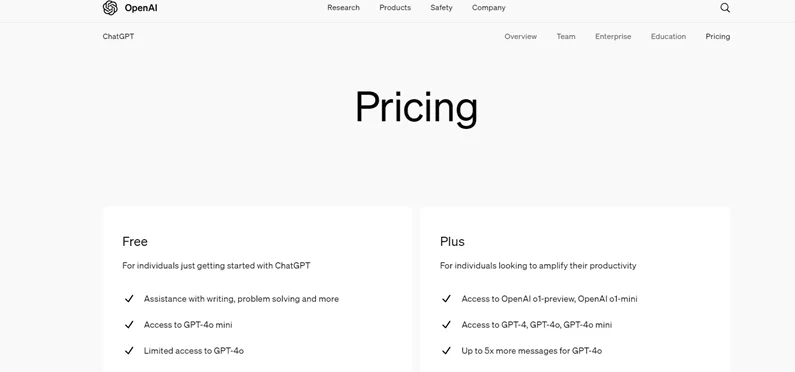
The next step is to create an account and then choose a suitable version of ChatGPT. The platform offers two models: ChatGOT 3.5, which is free, and the second one is GPT 4 (ChatGPT Plus), which will cost you $20/month.
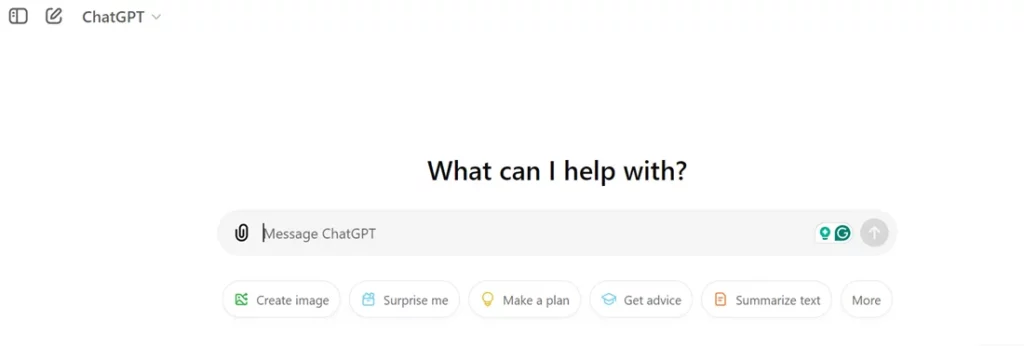
Once you have chosen your desired model, you can navigate to ChatGPT through your preferred interface. The platform allows you to use it on your web browser and also provides Android and iOS applications, making it accessible to everyone.
While talking about how to use ChatGPT, you must be wondering how you can use it on your mobile or desktop devices. To address that matter, we have broken this down into simple steps in the following section. So, let's start to learn how to use ChatGPT on different devices.
To use ChatGPT on the web:
To use ChatGPT on mobile:
For a dedicated ChatGPT experience on your desktop:
Using ChatGPT across these devices is simple and provides flexibility to access it wherever you are.
Now that you have learned how to use ChatGPT across different devices, let's learn how to write effective prompts to get optimized results.
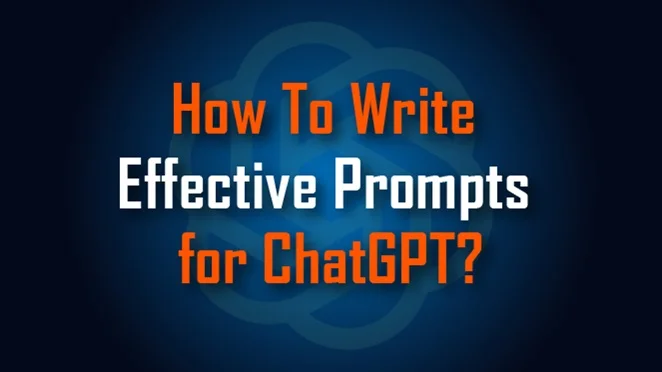
Writing effective prompts for ChatGPT is essential to getting accurate, valuable responses. A well-structured prompt guides the AI, helping it understand the context and deliver more insightful answers.
Effective prompts save time, reduce the need for multiple corrections, and enhance the user experience by delivering relevant information on the first attempt. Whether you're using ChatGPT for professional work, creative writing, or general inquiries, mastering prompt writing techniques is the key to unlocking the AI's full potential.
Below, we will explore best practices for crafting clear prompts, using follow-ups, and experimenting with various prompt styles.
To make the most of ChatGPT, clarity and specificity are critical when writing prompts. A clear prompt minimizes ambiguity, guiding the AI to focus on relevant details and improving response accuracy. Here’s how to make your prompts more precise:
Following these tips helps create clear, concise prompts that yield targeted answers, enhancing productivity and efficiency.
Sometimes, initial prompts may produce answers that need further clarification. This is where follow-up prompts come in. Follow-ups allow you to narrow down or expand on details, improving the quality of responses:
This repetitive approach makes it easy to refine responses, delivering highly accurate information.
Exploring different prompt styles opens up new possibilities in ChatGPT's responses, enabling you to match the output to specific needs.
Here are some popular prompt styles to experiment with:
By experimenting with prompt styles, you can customize responses for different use cases, making ChatGPT a versatile tool that adapts to various content needs. In the next section, we will explain some of the practical use cases of ChatGPT so that things can be more understandable.
Have you ever wondered how you can use ChatGPT to meet your specific needs? Well, we have mentioned the top practical use cases of using ChatGPT so that you can learn how to use it properly in a relevant sector. So, let's explore it gradually!
The use of ChatGPT has revolutionized the marketing sector and elevated it to new heights. From email generation to ad copy creation to increase sales, this AI-powered tool has you covered.
Furthermore, ChatGPT can also be used to automate your customer support messages so that you can provide them with more precise solutions. Along with this automation, ChatGPT also aids in brainstorming new ideas for marketing campaigns.
But how?
Well, the process involves the following steps:
ChatGPT is a powerful tool for marketers looking to enhance customer engagement and personalize their content. By analyzing large amounts of user data and identifying patterns, ChatGPT can generate targeted, personalized content based on individual customer preferences. This whole approach helps you increase marketing effectiveness.
In addition, marketers can also take advantage of ChatGPT-powered AI chatbots as part of their customer service and chatbot marketing strategy– which enables faster, tailored responses to customer inquiries, from product recommendations to addressing common questions.
That is how you can use ChatGPT to automate or boost your marketing efforts exponentially.
In programming and development, documentation of your code is one of the most crucial parts for every developer. ChatGPT comes with great ease in that perspective. It can generate high-quality and easy-to-understand code documentation so that your team can understand each and every line of code effectively.
This approach allows you to generate bug-free code documentation with ease.
But How?
Using ChatGPT for schoolwork can be a game-changer for students seeking quick insights, study support, and guidance in tackling assignments. However, using ChatGPT effectively requires knowing how to use it properly and responsibly.
In the following section, we have crafted a detailed guide on how to use ChatGPT to help with school assignments, research, and studying. Let’s have a look at it!
ChatGPT can assist with assignments, but it’s essential to approach it as a guide rather than a substitute for original work. Here are some specific ways it can help:
ChatGPT can be a powerful tool to guide you through the research phase, but keep in mind that it’s not a replacement for verified sources. Here’s how to get the most out of it:
Using ChatGPT as a study tool can help you strengthen your understanding of subjects and improve your study sessions.
ChatGPT has rapidly become a popular tool in content creation, transforming how bloggers, marketers, and writers approach their work. With its versatile applications, ChatGPT can streamline blogging, editing, and brainstorming, making it an invaluable assistant for content creators. Here’s a deep dive into how to use ChatGPT effectively across each of these areas.
Blogging requires a mixture of creativity, SEO knowledge, and a clear understanding of the audience. ChatGPT can support each step of the process, from topic generation to final edits.
ChatGPT can help you generate ideas that align with your niche, focusing on trending or evergreen topics that appeal to your target audience. For example, you can ask it, “What are some popular blog topics for personal finance in 2024?” It will generate a list of high-interest topics that are likely to attract readers.
Based on your topic, ChatGPT can provide keyword suggestions that can guide SEO strategy. Keywords like “how to save for retirement” or “budgeting tips for families” can be incorporated to improve search engine rankings.
ChatGPT can generate structured outlines for a range of blog formats, such as listicles, how-to guides, or in-depth analyses. For instance, if you’re writing a “Top 10 Travel Destinations” post, it can suggest headings, subheadings, and points to cover under each.
Struggling with an engaging introduction? ChatGPT can generate different styles of opening lines or hooks that capture readers’ attention, as well as compelling conclusions that encourage further engagement.
By inputting your topic and desired length, ChatGPT can provide a first draft or specific sections of your post. It’s particularly useful for getting past writer’s block, as it can produce a rough draft that you can then refine and personalize.
ChatGPT can help integrate keywords smoothly, suggest meta descriptions, and recommend user-friendly language that aligns with Google’s NLP models, ensuring your content is well-optimized for both readers and search engines.
Editing is crucial for producing high-quality content that resonates with your audience. ChatGPT can serve as a second pair of eyes, offering suggestions for improving clarity, coherence, and readability.
ChatGPT can quickly catch basic errors in spelling, grammar, and punctuation. Simply paste a section of text, and it will flag errors or offer corrections, saving you time on initial proofreading.
For content that sounds awkward or overly complex, ChatGPT can suggest simpler alternatives, making your writing more accessible and engaging for a broader audience.
ChatGPT can help break down complex sentences, transforming them into more concise, clear statements. This is particularly useful for keeping content engaging for a general audience and aligning with Google’s NLP preference for natural, easy-to-read language.
By reviewing sections individually, ChatGPT can suggest transitions or reorganize paragraphs to improve flow and cohesion. For example, if you’re writing a tutorial, ChatGPT can ensure that each step logically follows the previous one, creating a smooth reading experience.
Whether you need a professional, conversational, or humorous tone, ChatGPT can adapt text to suit the specific style you’re aiming for. For instance, it can make formal content sound more approachable or elevate casual language to a more polished level.
ChatGPT can help ensure consistency in tone and style across long-form content, keeping your voice steady and on-brand throughout the piece.
Brainstorming is where ChatGPT’s versatility truly shines. Whether you’re developing new ideas for content or crafting innovative solutions to engage your audience, ChatGPT can offer endless inspiration.
You can prompt ChatGPT to generate lists of ideas based on specific themes, audiences, or current events. For instance, if you need fresh ideas for a technology blog, you might ask, “What are some trending topics in AI for 2024?”
Crafting catchy, SEO-friendly titles can be time-consuming, but ChatGPT can quickly suggest options. For instance, you can request, “Give me some engaging blog title ideas about sustainable fashion,” and it will provide suggestions with strong click potential.
Using keywords you’ve identified, ChatGPT can help generate new angles or perspectives for your content. For example, if “remote work productivity” is your keyword, ChatGPT can offer variations like “Best Apps for Remote Work Productivity” or “How to Avoid Burnout While Working Remotely.”
ChatGPT can tailor ideas to specific demographics, focusing on topics and language that resonate with your target readers. By providing details about your audience, you can receive more relevant and focused suggestions.
ChatGPT can suggest effective CTAs to engage readers, from prompts to share the article on social media to questions that encourage comments and interaction.
If your blog benefits from visual elements, ChatGPT can suggest relevant ideas, such as infographics, image ideas, or interactive components like quizzes, which can help increase user engagement and time on the page.
While ChatGPT is a versatile and powerful tool, it’s crucial to use it ethically.
Here are some guidelines to keep in mind:
Use ChatGPT as a supplement, not a replacement, for your work. Always put ideas in your own words and cite sources if required.
ChatGPT’s responses are based on existing data and may not always be fully accurate or current. Cross-reference its information with reliable sources.
Let ChatGPT guide your study process and enhance understanding, but avoid using it to produce answers directly for assignments or exams.
Using large language models like ChatGPT enhances your daily productivity, creativity, and problem-solving skills. To make the most of your experience, understanding how to interact with it effectively can lead to better responses, enhanced workflows, and even creative breakthroughs.
In this section of our How to use ChatGPT, we will explore how you can maximize your experience and provide some tips and steps. So, let’s explore it.
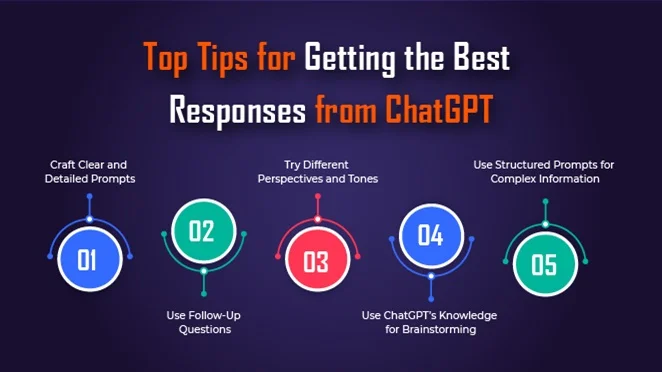
ChatGPT is one of the largest machine learning platforms that provides you with text-based responses instantly. To optimize your experience with this AI chat assistant, you need to follow these tips:
The more specific and detailed your prompt, the more accurate and helpful ChatGPT’s response will be. When you provide context and examples or ask for a certain tone, ChatGPT can better understand your needs and deliver exactly what you’re looking for.
For example, instead of asking, "How do I write a blog?" try to ask, "What are the key steps to writing an engaging blog post about fitness for beginners?"
Don’t be afraid to ask ChatGPT follow-up questions. The more you refine your prompts, the more AI responses get better. That is why if the initial answer isn’t perfect, you can adjust your question for more depth, specific points, or examples. This iterative approach helps refine ChatGPT's output to suit your goals.
ChatGPT can respond with various tones and perspectives, from formal to conversational or from technical to creative. For instance, if you’re writing a social media post, specify that you’d like a friendly and engaging tone. Experiment with asking ChatGPT to generate responses from different angles, and choose the style that fits your purpose.
ChatGPT is a powerful brainstorming tool for idea generation. Whether you're stuck on blog post topics, product names, or campaign ideas, a prompt like “Give me 10 creative ideas for an eco-friendly product launch” can unlock new perspectives and expand your options.
If you need detailed insights or multi-step answers, use structured prompts. You can ask ChatGPT to break down steps, list pros and cons, or summarize information in bullet points. This is especially useful when researching complex topics or building guides.
Following the above tips and tricks, you can optimize your experience while using the ChatGPT platform. Now, we are about to explore how you can increase your productivity and creativity using ChatGPT. So, keep reading it!
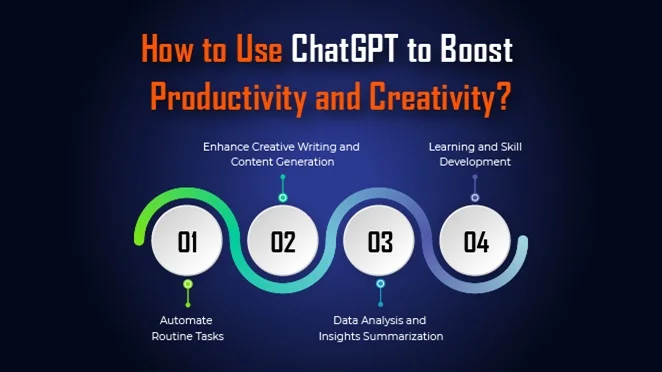
The use of ChatGPT not only enhances the research process but also aids in various other aspects. From task automation to social media content management, this AI-powered tool has got you covered.
Let’s have a look at the following key areas.
When it comes to tas automation, ChatGPT provides extensive assistance. It can help with common tasks like drafting emails, summarizing documents, or generating quick reports. This saves time on repetitive tasks and allows you to focus on more strategic aspects of your work.
ChatGPT can act as a writing assistant, helping you generate ideas, refine drafts, or overcome writer’s block. You can use it for everything from blog post inspiration to refining social media captions or even drafting longer articles.
ChatGPT can simplify data-heavy information by summarizing key points or generating high-level insights, which is useful for quick decision-making. For example, you can paste data or information from a report and ask ChatGPT to “Summarize the key insights from this report in a paragraph.”
Use ChatGPT as a resource to quickly learn new skills, tools, or concepts. Whether it’s for coding, digital marketing, or industry-specific knowledge, asking ChatGPT-targeted questions can help you expand your expertise and find the best resources for further learning.
That is how you can boost your productivity using ChatGPT power.
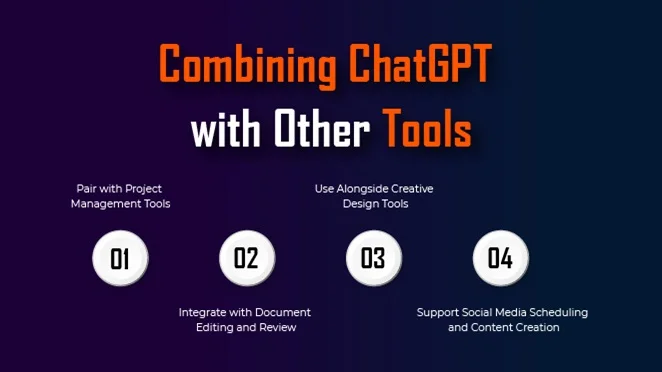
When we use ChatGPT with other productivity and project management tools, things get so versatile and exclusive that they make your performance better. This section of our discussion will reveal to you how ChatGPT can be integrated with other tools and make your workflows super fast and efficient.
Use ChatGPT to draft project outlines, create timelines, or even brainstorm project ideas. It can be combined with project management software, such as Slack, Toptal, and much more. This approach can streamline project planning and help teams stay organized.
Generate drafts in ChatGPT, then transfer them into a word processor for further editing and formatting, like Microsoft Word, Google Docs, or Notion. This approach allows you to refine content generated by ChatGPT, making it ready for publication or internal use.
ChatGPT is a versatile tool to brainstorm visual themes, tagline ideas, or content concepts that align with your design projects. For branding, it can suggest colors, messaging styles, or design themes to match your vision.
Paired with tools like Canva for easy-to-use templates, Adobe Creative Cloud for professional-quality graphics, and Figma for collaborative UI/UX prototyping. Additionally, it can also be used in Procreate for detailed illustrations and can inspire cohesive, polished designs.
This mixture of AI-driven ideas with creative platforms enhances your workflow, taking projects from concept to completion smoothly.
ChatGPT can generate captions, hashtags, or content ideas, which you can then schedule in a social media management tool. This streamlines content creation, keeping your social media calendar fresh and engaging without requiring extensive brainstorming sessions.
By using ChatGPT strategically in your workflows, you can unlock new efficiencies, boost creativity, and enhance your productivity. Whether for brainstorming, daily tasks, or skill-building, ChatGPT’s capabilities offer a flexible and powerful tool that can adapt to a wide range of needs.
However, there are some privacy and security concerns that you must be aware of while using ChatGPT for any purpose. To acknowledge them, we have discussed them in the next section for your ease of understanding. Let’s find out more about it.
The users of ChatGPT are increasingly growing, and due to that reason, data privacy and security become essential topics. Managing your data effectively within ChatGPT ensures that your information is kept safe while also allowing you to control what is remembered and stored.
Here’s how you can manage your chat data and understand ChatGPT’s data usage policies.
Managing your data in ChatGPT is simple and customizable. Whether you're concerned about privacy or just want to keep your chat history organized, ChatGPT offers several tools to manage your information. Here are some ways you can use to manage your data using ChatGPT.
ChatGPT automatically remembers certain preferences and details from your conversations to provide you with more personalized responses. To manage this:
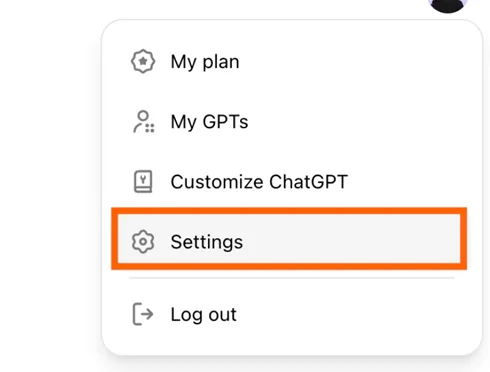
Note: Deleted memories are retained by OpenAI for up to 30 days for safety and debugging.
For one-off conversations without memory storage, use temporary chats. Simply toggle the Temporary Chat option while starting a conversation. Remember that while your temporary chats won't appear in the history, OpenAI might keep them for up to 30 days for security purposes.
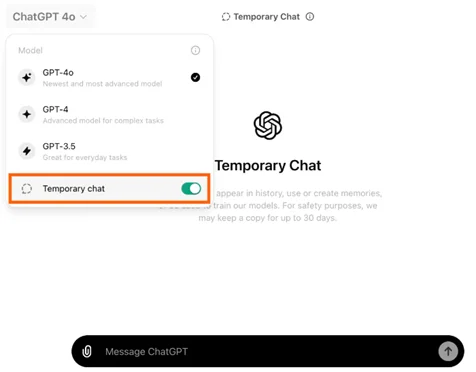
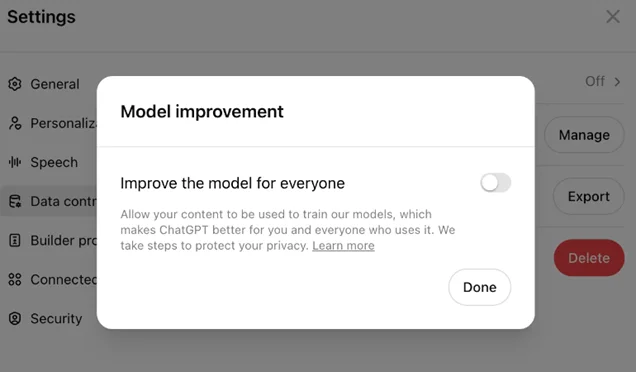
ChatGPT uses conversations and memories to improve its models. If you prefer not to contribute, you can do this by going to Settings, selecting Data Controls, and disabling the Improve the Model for Everyone option.
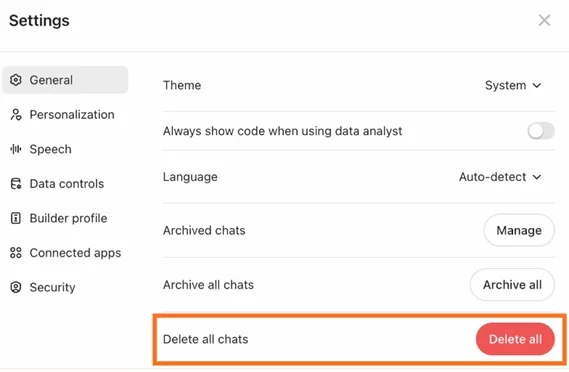
You can delete or archive your ChatGPT conversations to manage your data. Here is how you can perform these actions:
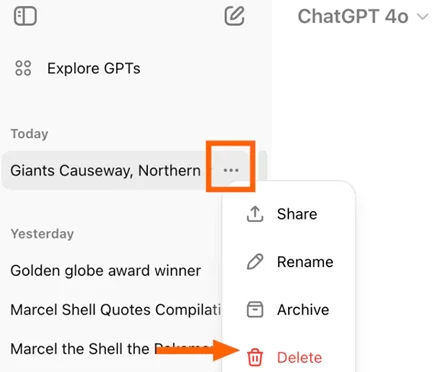
You can also delete your specific chat on CHatGPT. All you need to do is to hover over any conversation in the sidebar, select Options, and click Delete.
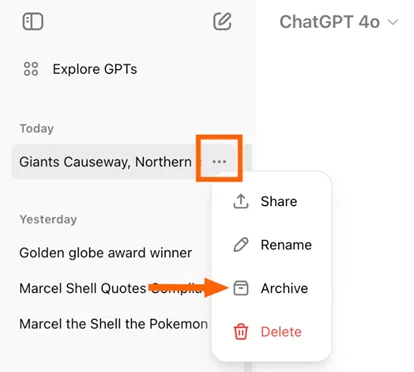
Archiving allows you to hide but retain conversations from your sidebar. To do so, you need to follow these steps:
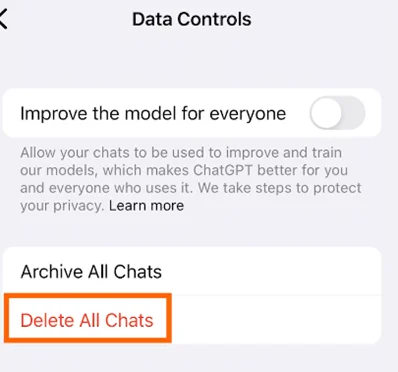
You can manage data on both desktop and mobile apps. For the mobile app, you can delete specific chats or archive them by holding the conversation name and selecting the relevant option in the app's menu.
That's how you can effectively use ChatGPT to secure your data.
At the end of our discussion on how to use ChatGPT, we can summarize that it is a versatile tool that depends on how you interact with it. Whether you use it without any purpose or make its better use, it all depends on your way of engaging; that is why AIChief has done its research and crafted this guide for you. So, learn how to use ChatGPT effectively and optimize your experience with it.
Yes, ChatGPT offers a free version that anyone can use, though it has some limitations compared to the paid plans. The free tier provides access to essential features, while premium plans, like ChatGPT Plus, offer enhanced capabilities, faster responses, and access to the latest model versions.
ChatGPT’s responses are generally accurate but may vary depending on the question’s complexity and clarity. While it’s designed to provide reliable information, it may occasionally produce errors or misunderstand complex queries. For critical information, it’s always wise to verify responses.
No, using ChatGPT requires you to create an account, even for the free version. Creating an account helps keep track of usage and personalizes the experience based on your settings.
The free version of ChatGPT gives users access to the base model, but it has slower response times and limited capabilities. Paid plans, like ChatGPT Plus, provide access to advanced models, faster response times, and priority during high-traffic periods, enhancing the user experience.
ChatGPT has limited memory within a single conversation, but it doesn’t retain information between separate sessions. However, OpenAI is working on features to allow longer-term memory, which may be available in future updates.
Yes, ChatGPT can handle complex questions across a wide range of topics. However, for highly technical or specialized queries, the accuracy may vary. Providing clear and specific questions can help improve the quality of the answers.
To get the best responses from ChatGPT, try providing clear, detailed questions. If needed, add relevant context to help ChatGPT understand your query. Experimenting with rephrasing or breaking down complex questions can also improve response accuracy.